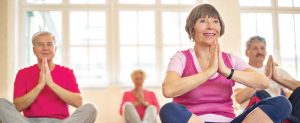Improve the Aging Brain and Well-Being with Mindfulness Training
By John M. de Castro, Ph.D.
“On average, the brains of long-term meditators were 7.5 years younger at age 50 than the brains of non-meditators, and an additional 1 month and 22 days younger for every year after 50.” – Grace Bullock
The aging process involves a systematic progressive decline in every system in the body, the brain included. This includes our cognitive (mental) abilities which decline with age including impairments in memory, attention, and problem-solving ability. It is inevitable and cannot be avoided. Research has found that mindfulness practices reduce the deterioration of the brain that occurs with aging restraining the loss of neural tissue. Indeed, the brains of practitioners of meditation and yoga have been found to degenerate less with aging than non-practitioners. Tai Chi and Qigong have also been shown to be beneficial in slowing or delaying physical and mental decline with aging.
In today’s Research News article “Long-Term Physical Exercise and Mindfulness Practice in an Aging Population.” (See summary below or view the full text of the study at: https://www.frontiersin.org/articles/10.3389/fpsyg.2020.00358/full?utm_source=F-AAE&utm_medium=EMLF&utm_campaign=MRK_1293822_69_Psycho_20200407_arts_A), Tang and colleagues recruited healthy older participants who practiced for an hour a day 6 – 7 days a week for 12 years either physical exercise, aerobic walking, or integrated mind-body training, including body relaxation, mental imagery and mindfulness training. The participants underwent brain imaging with functional Magnetic Resonance Imaging (fMRI). They had their heart rate, respiration. and skin conductance recorded during a fitness exercise session. Salivary Secretory immunoglobulin A (sIgA), an index of mucosal immunity and Cortisol levels, an index of stress, were measured at rest, during stress, and during training. They also completed scales measuring general health and quality of life.
They found that the mindfulness group had significantly higher resting heart rate and respiration, high frequency heart rate variability, quality of life, and sIgA levels and significantly lower cortisol levels and skin conductance than the exercise group. In addition, they found that the mindfulness group compared to the exercise group had significantly larger brain striatum including the caudate and putamen and significantly greater functional connectivity between the dorsal anterior cingulate cortex and the striatum and also the insula.
These results are interesting and suggest that long-term mindfulness practice results in differences in the psychological, physical, and neural states compared to physical exercise. Psychological well-being improvement in the mindfulness group was suggested by the greater reported quality of life. Physiological improvements in the mindfulness group were suggested by greater relaxation as indexed by greater autonomic nervous system, parasympathetic activity and measured by heart rate variability and skin conductance and lower stress hormone, cortisol, levels. The greater volume of the striatum and greater connectivity with the dorsal anterior cingulate cortex also suggest greater physiological relaxation. The mindfulness group also showed greater immune system function as indexed by sIgA levels. On the other hand, the aerobic walking group demonstrated greater physical fitness as indexed by lower resting heart rate and respiration.
In sum, these findings suggest the long-term aerobic walking exercise is good for the physical fitness of older adults. But long-term mindfulness training is better for their overall psychological and physical well-being. These results correspond with other prior findings that shorter-term mindfulness practice results in greater autonomic relaxation, quality of life, and neuroplastic changes in brain systems and that this training reduces the physiological and psychological deterioration occurring with aging.
So, improve the aging brain and well-being with mindfulness training.
“Mind and body practices, in particular, including relaxation techniques and meditative exercise forms such as yoga, tai chi, and qi gong are being used by older Americans, both for fitness and relaxation, and because of perceived health benefits.” – National Center for Complementayy and Integrative Health
CMCS – Center for Mindfulness and Contemplative Studies
This and other Contemplative Studies posts are also available on Google+ https://plus.google.com/106784388191201299496/posts and on Twitter @MindfulResearch
Study Summary
Tang Y-Y, Fan Y, Lu Q, Tan L-H, Tang R, Kaplan RM, Pinho MC, Thomas BP, Chen K, Friston KJ and Reiman EM (2020) Long-Term Physical Exercise and Mindfulness Practice in an Aging Population. Front. Psychol. 11:358. doi: 10.3389/fpsyg.2020.00358
Abstract
Previous studies have shown that physical exercise and mindfulness meditation can both lead to improvement in physical and mental health. However, it is unclear whether these two forms of training share the same underlying mechanisms. We compared two groups of older adults with 10 years of mindfulness meditation (integrative body-mind training, IBMT) or physical exercise (PE) experience to demonstrate their effects on brain, physiology and behavior. Healthy older adults were randomly selected from a large community health project and the groups were compared on measures of quality of life, autonomic activity (heart rate, heart rate variability, skin conductance response, respiratory amplitude/rate), immune function (secretory Immunoglobulin A, sIgA), stress hormone (cortisol) and brain imaging (resting state functional connectivity, structural differences). In comparison with PE, we found significantly higher ratings for the IBMT group on dimensions of life quality. Parasympathetic activity indexed by skin conductance response and high-frequency heart rate variability also showed more favorable outcomes in the IBMT group. However, the PE group showed lower basal heart rate and greater chest respiratory amplitude. Basal sIgA level was significantly higher and cortisol concentration was lower in the IBMT group. Lastly, the IBMT group had stronger brain connectivity between the dorsal anterior cingulate cortex (dACC) and the striatum at resting state, as well as greater volume of gray matter in the striatum. Our results indicate that mindfulness meditation and physical exercise function in part by different mechanisms, with PE increasing physical fitness and IBMT inducing plasticity in the central nervous systems. These findings suggest combining physical and mental training may achieve better health and quality of life results for an aging population.
